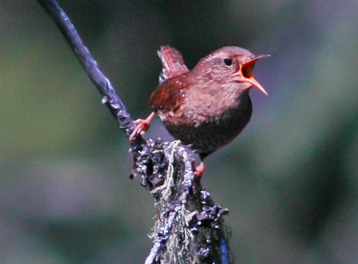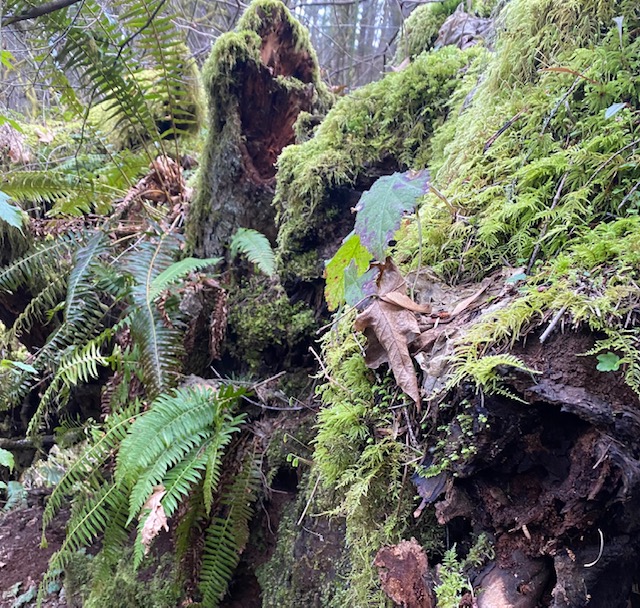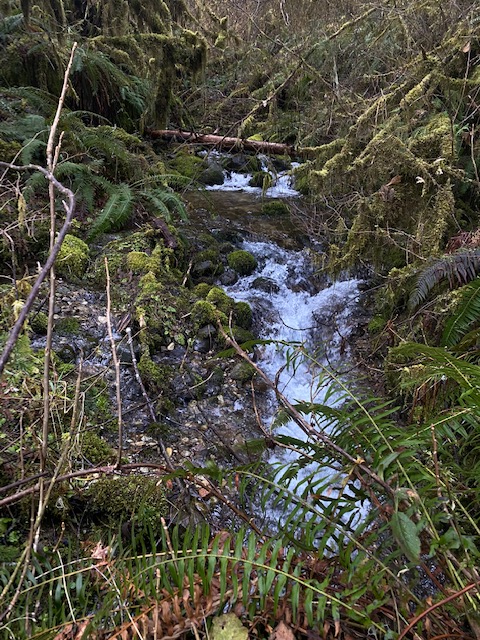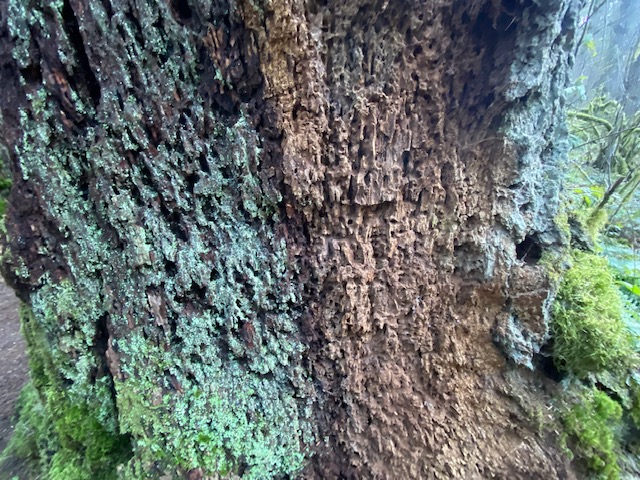My ears are chiming with Pacific wren song long after I’ve left the “Old-Growth Trail” in McDonald Forest above Corvallis. The cinnamony birds with pert, flicked-up tails are hard to spot among mossy nurse logs, ferns, lichen-draped branches, and the wide trunks of Douglas-firs surging skyward. And the songs of males?
The notes are a high-speed tumbling of enunciated whistled notes that rise and fall like frothing bubbling waters of a fern-embraced brook. Every flinging droplet is a note in a complex song pouring forth from thin bills at breathtaking rates. They are the troubadours of the season of courting, mating, nesting, and renewing.

When I stopped to scan the understory for the invisible male pouring his heart out in patterned melodies, my senses sharpened. I noticed details I might have missed had not the singing arrested me in mid-step. In the coolness of the morning, I inhaled the rich humus of soils nurtured by fallen trees returning to earth.
My hand reached for the nearest trunk to press lightly upon airy emerald moss. Scanning for the elusive songster somewhere close to fallen tree nourishing new life and sheltering salamanders, I heard the faint tinkling notes of golden-crowned kinglets hundreds of feet above me in the canopy. Barely visible among ferns nearby, a Douglas squirrel with liquid brown eyes dug for tasty fungi with practiced paws.

The night before, I’d given a talk on my book Halcyon Journey, In Search of the Belted Kingfisher to the Audubon Society of Corvallis. I’d shared the way one bird led me through the labyrinth of life along a home creek with a staccato riff of calls. While not a songbird, a kingfisher offers intriguing variations–from loud rattles of disapproval when humans come too close to the soft birdy trills of a lone bird musing above the currents as if conversing with the waves.
A Pacific wren can sing circles around every songbird of remnant ancient forests. Ornithologist Donald Kroodsma called this wren’s acoustical abilities the “pinnacle of song complexity.” Known for his studies of avian songs and his sensory, first-person yet scientific book The Singing Life of Birds, Kroodsma studied this songster back in 1970 in the McDonald Forest (an Oregon State University Research Forest). I wonder if any of the wrens I heard were descendants of the two males he studied?
Describing recording a male in the McDonald Forest after dawn on April 4, 1970, Kroodsma noted the wren began his arias perched high in a Douglas-fir and then flew down to the forest floor, where he sang off and on for three hours. Analyzing and graphing the songs later that day, he identified 441 songs, some with the same introduction. But the second half of the songs are where he “unleashes his creative bent.” Over two mornings, he recorded 831 songs with 67 variations.
The wren dazzles with improvisations sure to win the attention of a female or outcompete a rival male. Wrens learn songs when young from their neighbors within the equally complex forests.

Opening up Kroodsma’s The Singing Life of Birds to the winter wren (before winter and Pacific wrens were split into two species thanks in part to his acoustic studies), I read his description of the wren’s operatic performance within magnificent forests of the Pacific Northwest, compared to the simpler melodies of what would become the winter wren of the East officially (See Sibley’s range maps for the two species).
“He sings at breakneck speed and at a much higher pitch. His song is a blur, the notes so brief, so minute so high that my human ears cannot pick them out, my head spinning as I try, it being challenge enough just to listen and breathe at the same time.”
Tucked within Kroodsma’s narrative is this gem that resonates with me. I, too, have longed to know the world of the kingfisher not as the observer, but as the bird. He wrote:
“I would love to know more about this wren. His songs are so expressive, ranging from the loud and vehement to soft warbles, to whispers of sibilant notes that might be audible only a few inches from the bird. Perhaps only if I were a wren for a day would I know all he is saying and thinking.”
Yes, I would, too. At least I might attempt to decipher the songs so I might know what wrens are hearing. I turn to the radio program Bird Note and listen to a Pacific wren male at normal speed and then slowed down to quarter speed. The notes become fluting haunting melodies flowing through every limb and encircling my heart.
Sing Pacific wrens. Your songs are life springs, freshets, and promises of bud, blossom, and metamorphosis. Sing for the spiders lacing silk from fern to fern. Sing for sap rising, needles photosynthesizing, and carbon sequestered and stored deep in the trunks and roots of the ancient ones. Sing the insects that you pluck from moss and lichen–of beetles, caterpillars, ants, mites, ticks, millipedes, flies, and bees. Sing woven nests lined in feathers, rootlets, moss, and animal hair, and nestled into the roots of fallen trees.
Sing the tapestry and miraculous complexity mirrored in melodies beyond all human ability. Sing the lush and multi-layered world of the ancient forest–your home that is ever harder to find among logged forests, a world we must work ever harder to protect. Let us know your ways. Reach for our flutes, our recorders, or purse our lips and whistle.
#
- Read more on the Pacific Wren: All About Birds
- What I am reading (and listening to the audiobook)– highly relevant and I recommend: An Immense World, How Animals Senses Reveal the Hidden Realms Around Us, by Ed Yong.








Beautiful, Marina. This piece is both poetic and informative. Makes me want to know more about the Pacific Wren. And thanks, as always, for your excellent photos. xoA ❤
LikeLiked by 1 person
The bird seeing nightingale bird same , so marvelous 👌🌹🙏 So deep forest and
Trees , specially the big hole on tree breathtaking , nature wonders 🌹🙏❤️🌹
LikeLiked by 1 person
Love this. Love the photos too. Sitting quietly
LikeLike
So amazing! This one went right to my core. Your insightful delightful woodland descriptions took me right into the damp forest with you. The flinging droplets of sound, perfectly fits the Pacific Wren…so tiny, so hard to see and yet surrounding us with its elaborate flutey song. Thank you, Marina❣️
LikeLiked by 1 person
Thank you for this celebration ‘poem’ about this wren! Reading your piece was almost as lovely as hearing the birds! We are blessed to have Pacific Wrens visit us in the Upper Deschutes especially in the autumn, but it is rare to hear them sing their full repertoire here, so thank you for bringing their songs to us in this post!
LikeLiked by 1 person
It was a challenge for me to find my first one. I have to be fairly close to them to hear them. My first photograph was of one singing but I was too far away to hear it.
Thank you for the link to the slowed down song … very informative and just cool.
LikeLike